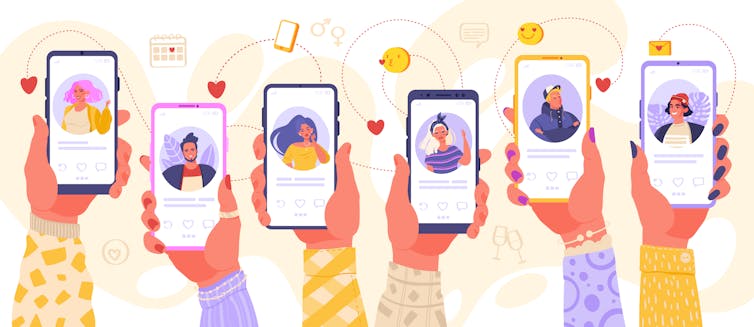
Anthony Fong, University of Toronto
You’ve decided to go out with that stranger you met online, despite COVID-19 cases being on the rise worldwide. But in the back of your mind, the risk of infection still bothers you. Is there a safer way to do this?
Health declarations on dating apps — a more frequent occurrence of late — may be one answer.
While fear of COVID-19 has created a surge of citizens openly declaring their vaccination status on dating apps like Hinge and Bumble, experts say app companies are looking at how to promote and facilitate a similar openness when it comes to sharing sexual health information.
In the case of sexually transmitted infections (STI), the opportunity has rekindled a debate about whether apps help or hinder public health efforts to control spread, and how much responsibility app providers bear in taking care of their users’ sexual health.
Apps’ responsibility for care
“I definitely think that apps are responsible for their users,” says dating app and sexual consent researcher Chris Dietzel. He believes apps are legally bound to take care of users, but since they are for-profit companies, they shouldn’t be solely responsible. “There are many other health actors that might be more altruistic with their intentions,” says Dietzel.
One of these is the former medical director of Edmonton’s STI Clinic, Dr. Ameeta Singh. She says the apps should be doing more to curb STI spread among all users, regardless of sexual orientation.

The stakes are high. A trend of escalating STI rates in Canada, the United States and internationally has led to poor health outcomes like syphilis stillbirths, and doctors like Singh are pointing fingers at the apps as enablers of high-risk sex.
Singh says this risk from apps comes from the nature of meeting online. “Usually, [users] don’t know anything about the individual [they’re dating], their sexual behaviour or their risks for HIV and other STIs. It’s a riskier approach,” she says. And when someone tests positive for an STI, Singh says the apps make it hard for public health to do contact tracing — something done for many infectious diseases.
However, some disagree with Singh.
British Columbia-based public health and preventive medicine doctor Jason Wong says apps allow people to find more partners easily, but it doesn’t necessarily mean the apps are increasing STI transmission.
Dietzel co-authored a 2019 report reviewing the literature on risk in dating apps — he found no conclusive evidence to suggest app use increases the likelihood of catching an STI.
LGBTQ+ dating apps lead the way
When it comes to STI prevention, DaddyHunt general manager Casey Crawford says apps for LGBTQ+ communities are far ahead of their heterosexual counterparts. “We’re doing a much better job than some of the larger hetero-oriented apps in terms of allowing people to disclose their testing practices and creating public service announcements to educate people,” he says.
And Jen Hecht, senior director of Building Healthy Online Communities (BHOC), agrees. She says that apps for queer users are pioneers of STI risk-reduction features, particularly with HIV. She works closely with mostly queer dating apps to develop STI-prevention strategies and says apps are driving a movement to normalize the disclosure of health information.

But why the queer community? “One of the main factors is that you have generations of gay men who have lived through the AIDS crisis. That took a toll, but it also became part of their identity,” says Hecht, “It’s become a lot more normalized in the queer world to share that information.”
That profile information, in gay dating apps Adam4Adam, DaddyHunt, Grindr and GROWLr, could include:
- HIV status
- the date of your last test, and in-app test reminders
- if HIV positive, whether the virus is undetectable in your blood
- if HIV negative, whether you take PrEP (HIV prevention drugs)
- preference around condom use, etc.
Straight dating apps lag behind
Meanwhile, straight dating apps mostly lack all of the above. The only one that engages with BHOC’s work is Tinder. However, Hecht says Tinder profiles have a sparse structure that doesn’t lend itself to sharing details about STI risk, which tends to require more screen space.
Dietzel says the more conservative nature of straight dating apps may also be a barrier: “The apps that are marketed towards hetero-publics tend towards heterosexual norms of marriage, family and what’s expected in that type of relationship. And the queer apps are much more open about sexual health.”
After two weeks, the straight-oriented dating apps Bumble, Tinder, OKCupid and eHarmony did not respond to my requests for an interview.
The way forward
One thing that all stakeholders seem to agree on is that users need more education. Wong calls for “access to appropriate, non-stigmatizing sexual health education … Our messages need to be sex-positive and empowering.” One of these messages includes regular STI testing, even if you have no symptoms.
TakeMeHome is a home STI test kit that BHOC launched in March 2020. It has since been promoted by mostly queer dating partner apps as a COVID-safe testing option. Currently covered by public health only in select states across the U.S., Hecht hopes other jurisdictions will buy in.
As for the straight-oriented apps, Crawford says, “They should at a minimum be educating their members.”![]()
Anthony Fong, Dalla Lana Fellow, University of Toronto
This article is republished from The Conversation under a Creative Commons license. Read the original article.

